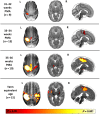Maturation of Sensori-Motor Functional Responses in the Preterm Brain
- PMID: 26491066
- PMCID: PMC4677983
- DOI: 10.1093/cercor/bhv203
Maturation of Sensori-Motor Functional Responses in the Preterm Brain
Abstract
Preterm birth engenders an increased risk of conditions like cerebral palsy and therefore this time may be crucial for the brain's developing sensori-motor system. However, little is known about how cortical sensori-motor function matures at this time, whether development is influenced by experience, and about its role in spontaneous motor behavior. We aimed to systematically characterize spatial and temporal maturation of sensori-motor functional brain activity across this period using functional MRI and a custom-made robotic stimulation device. We studied 57 infants aged from 30 + 2 to 43 + 2 weeks postmenstrual age. Following both induced and spontaneous right wrist movements, we saw consistent positive blood oxygen level-dependent functional responses in the contralateral (left) primary somatosensory and motor cortices. In addition, we saw a maturational trend toward faster, higher amplitude, and more spatially dispersed functional responses; and increasing integration of the ipsilateral hemisphere and sensori-motor associative areas. We also found that interhemispheric functional connectivity was significantly related to ex-utero exposure, suggesting the influence of experience-dependent mechanisms. At term equivalent age, we saw a decrease in both response amplitude and interhemispheric functional connectivity, and an increase in spatial specificity, culminating in the establishment of a sensori-motor functional response similar to that seen in adults.
Keywords: development; neonate; sensori-motor; task fMRI.
© The Author 2015. Published by Oxford University Press.
Figures






References
-
- Aeby A, Liu Y, De Tiege X, Denolin V, David P, Baleriaux D, Kavec M, Metens T, Van Bogaert P. 2009. Maturation of thalamic radiations between 34 and 41 weeks’ gestation: a combined voxel-based study and probabilistic tractography with diffusion tensor imaging. AJNR Am J Neuroradiol. 30:1780–1786. - PMC - PubMed
-
- Allievi AG, Melendez-Calderon A, Arichi T, Edwards AD, Burdet E. 2013. An fMRI compatible wrist robotic interface to study brain development in neonates. Ann Biomed Eng. 41:1181–1192. - PubMed
-
- Als H, Duffy FH, McAnulty GB, Rivkin MJ, Vajapeyam S, Mulkern RV, Warfield SK, Huppi PS, Butler SC, Conneman N et al. . 2004. Early experience alters brain function and structure. Pediatrics. 113:846–857. - PubMed
-
- Anderson AW, Marois R, Colson ER, Peterson BS, Duncan CC, Ehrenkranz RA, Schneider KC, Gore JC, Ment LR. 2001. Neonatal auditory activation detected by functional magnetic resonance imaging. Magn Reson Imaging. 19:1–5. - PubMed
Publication types
MeSH terms
Grants and funding
LinkOut - more resources
Full Text Sources
Other Literature Sources
Medical

